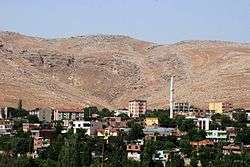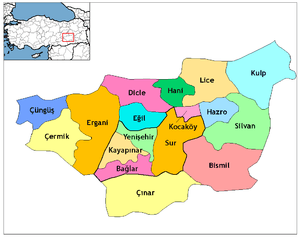Silvan, Diyarbakır
Silvan (Kurdish: Farqîn,[4] Ottoman Turkish: ميا فارقين Meyafarikîn,[5] Arabic: ميافارقين, Meiafarakin or Mayyafariqin; Armenian: Նփրկերտ, Np'rkert; Greek: Mαρτυρόπολις, Martyropolis; Syriac: ܡܝܦܪܩܝܛ, Mayperqiṭ) is a city and district in the Diyarbakır Province of Turkey. Its population is 41,451.[6]
Silvan | |
|---|---|
 | |
 Silvan | |
| Coordinates: 38°08′32″N 41°00′05″E | |
| Country | |
| Province | Diyarbakır |
| Government | |
| • Elected Mayor | Naşide Toprak (HDP) |
| • Kaymakam and Acting Mayor | Mehmet Uslu |
| Area | |
| • District | 1,397.14 km2 (539.44 sq mi) |
| Elevation | 810 m (2,660 ft) |
| Population (2012)[3] | |
| • Urban | 43,676 |
| • District | 86,450 |
| • District density | 62/km2 (160/sq mi) |
| Post code | 21640 |
| Website | www.silvan.bel.tr |
History
Silvan has been identified by several scholars as one of two possible locations (the other being Arzan) of Tigranakert (Tigranocerta), the ancient capital of the Kingdom of Armenia, which was built by King Tigran the Great (ruling 95–55 BC) and named in his honor.[7][8]
Roman era
In 69 BC, the army of Republican Rome defeated Tigran's troops in the battle of Tigranocerta. The city lost its importance as a thriving center for trade and Hellenistic culture in the following decades. In 387 AD, with the Peace of Acilisene, Tigranakert was made part of the Byzantine Empire.
Around 400 AD, the city's bishop, Marutha (later, saint Maruthas), brought a large number of relics back from Sassanid Persia. These were relics of Christian martyrs persecuted under Sassanid rule. For this reason it was renamed Martyropolis, "city of the martyrs." Following the reforms of Justinian I (rule 527–565), the city was made the capital of the province of Fourth Armenia.[9] The city was inconclusively besieged by the Persians in the last phase of the Iberian War.
The city suffered heavily in the Battle of Martyropolis in 588 AD, but soon prospered again.[10]
Islamic era
It was known by the name of Meiafarakin after the Arabs took over this region in the 7th century. It declined in importance over the centuries and became a minor Kurdish chiefdom during the rivalry era between the Safavids and Ottomans.[11]
Ottoman Empire
In 1896, reports by the British Vice Consul Hallward indicate that many villages were destroyed during the Armenian massacres in 1895. Hallward was engaged in the rebuilding of about 35 villages.[12]
21st century
The current Mayor is Naşide Toprak from the (HDP). She was elected in the local elections in March 2019.[13] She was dismissed in March 2020, and Mehmet Uslu has been appointed as a trustee instead of her.[14]
Silvan was the site of serious clashes between Turkish government forces and Kurdish Kurdistan Workers Party (PKK) separatists in August 2015 during the wider Operation Martyr Yalçın.[15]
Ecclesiastical history
People from Silvan
- Leyla Zana
- Rojen Barnas
- Yekta Uzunoglu[16]
- Mehdi Zana
Notable sites
See also
Notes
- "Area of regions (including lakes), km²". Regional Statistics Database. Turkish Statistical Institute. 2002. Retrieved 2013-03-05.
- "Where is Silvan, Turkey?". worldatlas.com. worldatlas. Retrieved 23 January 2019.
- "Population of province/district centers and towns/villages by districts - 2012". Address Based Population Registration System (ABPRS) Database. Turkish Statistical Institute. Retrieved 2013-02-27.
- Adem Avcıkıran (2009). Kürtçe Anamnez Anamneza bi Kurmancî (PDF) (in Turkish and Kurdish). p. 55. Retrieved 17 December 2019.
- Tahir Sezen, Osmanlı Yer Adları (Alfabetik Sırayla), T.C. Başbakanlık Devlet Arşivleri Genel Müdürlüğü, Yayın Nu 21, Ankara, p. 365.
- Statistical Institute
- Avdoyan, Levon. "Tiganocerta: The City 'Built by Tigranes'" in Armenian Tigranakert/Diarbekir and Edessa/Urfa. Richard G. Hovannisian (ed.) UCLA Armenian History and Culture Series: Historic Armenian Cities and Provinces, 6. Costa Mesa, CA: Mazda Publishers, 2006, pp. 94-95.
- (in Armenian) Hakobyan, Tadevos Kh. «Տիգրանակերտ» (Tigranakert). Armenian Soviet Encyclopedia. vol. xi. Yerevan: Armenian Academy of Sciences, 1986, pp. 699-700.
- Adontz, Nicholas (1970). Armenia in the Period of Justinian: The Political Conditions Based on the Naxarar System. Trans. Nina G. Garsoïan. Lisbon: Calouste Gulbenkian Foundation. p. 134.
- Edwards, Robert W., "Martyropolis" (2016). The Eerdmans Encyclopedia of Early Christian Art and Archaeology, ed., Paul Corby Finney. Grand Rapids, Michigan: William B. Eerdmans Publishing. p. 115. ISBN 978-0-8028-9017-7.
- Acikyildiz, Birgul (2014-08-20). The Yezidis: The History of a Community, Culture and Religion. I.B.Tauris. p. 48. ISBN 9781784532161.
- Verheij, Jelle (2012). Jorngerden, Joost; Verheij, Jelle (eds.). Social Relations in Ottoman Diyarbekir, 1870-1915. Brill. pp. 107–108. ISBN 9789004225183.
- "Diyarbakır Silvan Seçim Sonuçları - 31 Mart Diyarbakır Silvan Yerel Seçim Sonuçları". secim.haberler.com (in Turkish). Retrieved 2019-11-10.
- sabah, daily (2020-03-23). "5 HDP mayors in southeast Turkey detained in terror probe". Daily Sabah. Retrieved 2020-03-26.
- "Turkey and the Kurds: The hatred never went away". The Economist. 12 September 2015. Retrieved 12 September 2015.
- "Ana Sayfa". Yekta Uzunoglu (in Turkish). Retrieved 2018-08-10.
Further reading
- Amedroz, H. F. "The Marwanid Dynasty at Mayyafariqin in the Tenth and Eleventh centuries AD," JRAS, 1903, pp. 123–154.
- Minorsky, Vladimir. "Caucasica in the History of Mayyafariqin." BSOAS, Vol. 13, No. 1 (1949), pp. 27–35.
